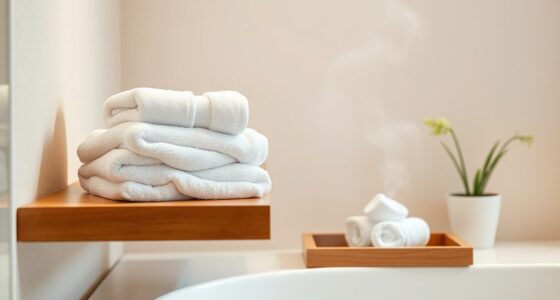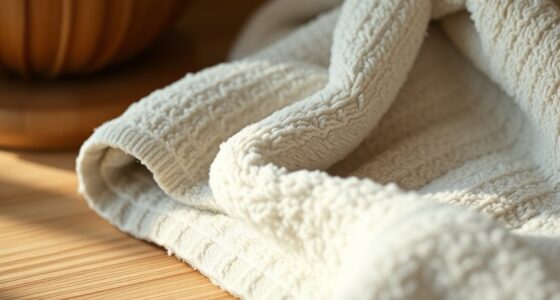Percale sheets feel crisp, cool, and breathable with a matte finish, making them great for hot sleepers and those who prefer a structured feel. Sateen sheets are softer, silkier, with a subtle sheen, offering a luxurious and cozy vibe. With proper care—like gentle washing and low tumble drying—both can last longer, but percale tends to be more durable. If you want to explore how to choose the right fabric, you’ll find more helpful tips ahead.
Key Takeaways
- Percale sheets feel crisp, cool, and matte, while sateen sheets are softer, silkier, with a subtle sheen.
- Percale’s tight weave enhances durability and resistance to pilling; sateen’s softer surface can snag more easily.
- Wash percale in warm water and tumble dry on low for longevity; for sateen, use cold water and gentle cycle to preserve softness and shine.
- Percale maintains its crispness after multiple washes, whereas sateen may soften and lose sheen over time if not properly cared for.
- Both fabrics require specific care to retain their feel: percale benefits from higher heat, while sateen prefers gentle washing and low drying.

When choosing between percale and sateen sheets, understanding their key differences can help you make an informed decision. One of the most important aspects to consider is thread density. Percale sheets typically have a higher thread count, often ranging from 200 to 400, which results in a tightly woven fabric. This high thread density makes percale sheets feel crisp, cool, and breathable—perfect if you tend to sleep hot or prefer a more matte finish. Sateen sheets, on the other hand, usually have a slightly lower thread count but are woven differently, with threads wrapped around each other to create a smooth surface. This weaving technique gives sateen a softer, silkier feel, even if the thread count isn’t as high as percale. As a result, sateen sheets tend to feel warmer and more luxurious, which many people find inviting, especially in cooler seasons.
Percale offers crisp, cool comfort with higher thread counts; sateen feels softer, warmer, and more luxurious with a lustrous sheen.
Fabric sheen plays a significant role in how each type of sheet looks and feels against your skin. Percale’s matte finish reflects minimal light, emphasizing its crispness and durability. Its surface has a cool, smooth feel that becomes even more invigorating after a night’s sleep. Sateen, by contrast, offers a subtle sheen that catches the light, giving it a more elegant, lustrous appearance. This sheen isn’t just visual; it also contributes to the fabric’s soft, almost buttery feel, making sateen sheets feel more indulgent and plush. If you’re drawn to sheets that look shiny and feel silky, sateen might be the better choice for you. However, if you prefer a more understated, classic look with a crisp touch, percale’s matte finish will likely appeal more.
Both fabrics are relatively easy to care for, but their different textures mean you should follow specific guidelines to keep them looking their best. Percale sheets tend to be more durable because of their tight weave and higher thread density, making them resistant to pilling and wear. They hold up well after multiple washes, maintaining their crispness. Sateen sheets, with their softer, smoother surface, can be more prone to snagging and may show signs of wear sooner if not cared for properly. To prolong their lifespan, wash sateen sheets in cold water on a gentle cycle and avoid harsh detergents. Tumble drying on low or line drying helps preserve their sheen and softness. Whichever you choose, following the manufacturer’s care instructions will keep your sheets feeling fresh and looking beautiful for years to come.
In the end, understanding the distinctions in thread density and fabric sheen helps you find sheets that match your comfort preferences and style. Whether you prefer the crisp, cool feel of percale or the luxurious softness and subtle shine of sateen, knowing these differences empowers you to select the right bedding for your needs.
Frequently Asked Questions
Which Fabric Is More Eco-Friendly to Produce?
You’ll find percale generally more eco-friendly to produce because it uses sustainable manufacturing practices and often involves fewer chemical dyes. Percale’s simple weaving process reduces environmental impact, and eco-friendly dyes further lessen pollution. Sateen, with its more complex finish, may require more resources and chemicals. So, if you want a fabric with a smaller environmental footprint, percale is the better choice.
How Do Temperature Settings Affect Percale and Sateen Longevity?
Ironically, cranking up the heat for laundering can actually shorten your fabric’s lifespan. Higher temperatures can weaken the fibers, reducing fabric durability over time. For both percale and sateen, sticking to cool or warm settings maintains their quality and longevity. So, you might think hotter is better, but gentle laundering ensures your sheets stay soft and durable longer, saving you money and frustration in the long run.
Can You Mix Percale and Sateen in One Bedding Set?
You can mix percale and sateen in one bedding set for a unique look, but avoid fabric blending, as the different textures may not hold well together. Instead, focus on design coordination by choosing complementary colors and patterns. This approach helps create a cohesive aesthetic while respecting each fabric’s individual qualities. Keep in mind that mixing fabrics might affect how long each piece lasts, so care and maintenance are key.
Are There Specific Detergents Recommended for Each Fabric Type?
Think of detergent preferences as choosing the right tools for each job. For percale, opt for a gentle, mild detergent to preserve its crisp feel, while sateen benefits from a fabric-specific cleaning that maintains its silky finish. Using the correct detergents guarantees your bedding stays soft and vibrant. Always follow care labels, and avoid harsh chemicals or bleach, which can damage these fabrics over time.
How Do Allergies Interact With Percale Versus Sateen Bedding?
If you have allergies, percale bedding might be better because its fabric breathability helps reduce dust mites buildup, which can trigger your symptoms. Sateen’s smoother surface can trap allergens more easily. To minimize allergy issues, wash your bedding frequently with a gentle, allergen-reducing detergent, regardless of fabric type. Using dust-mite-proof covers also helps protect you and keeps your sleeping environment healthier.
Conclusion
Choosing between percale and sateen depends on your personal feel and care preferences. Percale offers a crisp, cool touch, while sateen provides a silky, luxurious feel. Did you know that about 70% of shoppers prefer percale for breathability? Keep in mind, percale requires a bit more maintenance to stay crisp, but it’s worth it for the fresh comfort. Consider your sleep style and care routine to find the perfect match for a restful night.








